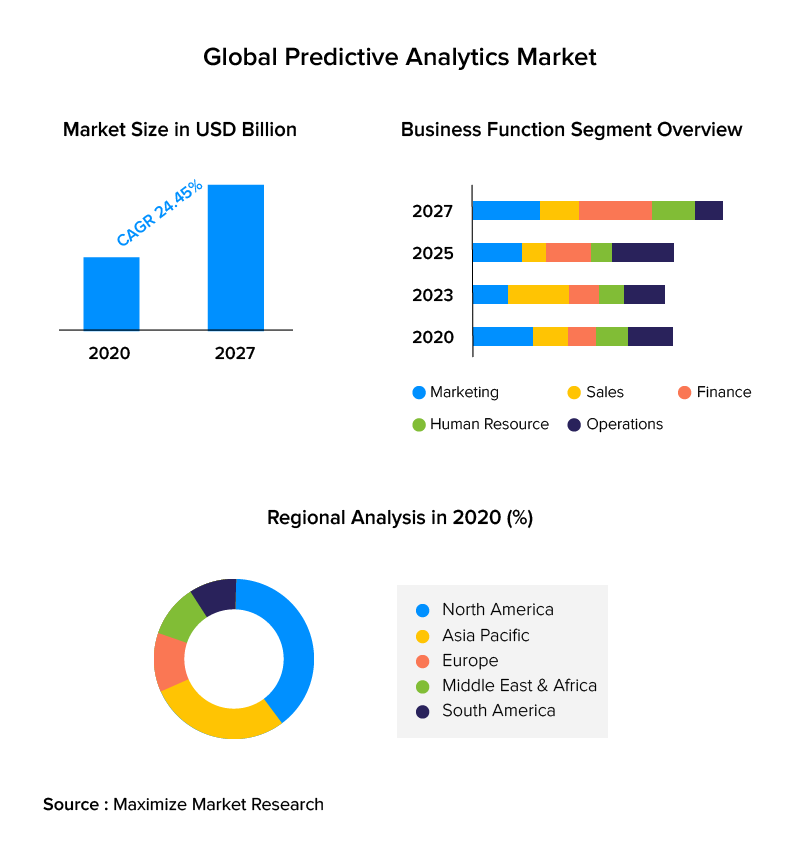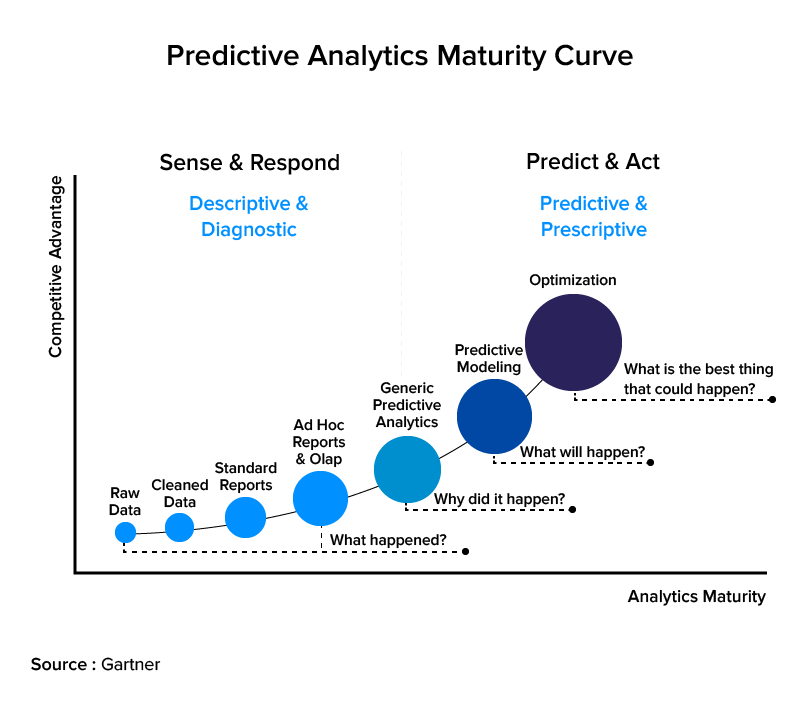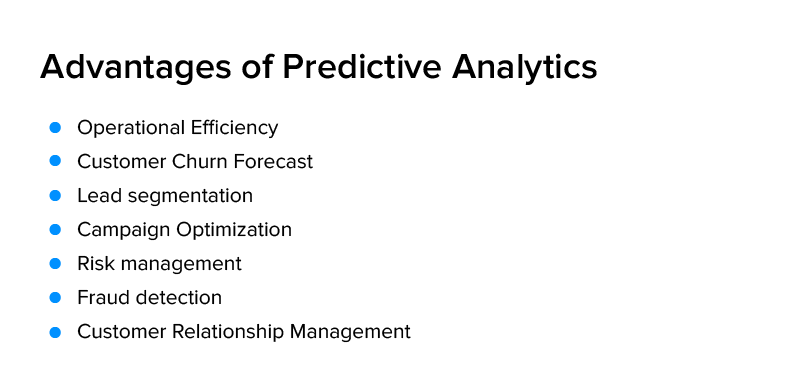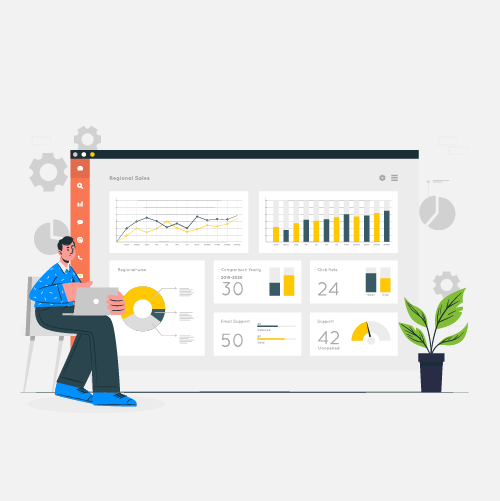Leveraging Predictive Project Analytics To Close Business Gaps
Every business owner hopes that they could look into the future and figure out the best ways to invest capital and resources while setting their company for long-term success. The next best thing is to extrapolate the opportunities that lie ahead using a deep grasp of what transpired in the past. Predictive analytics enables businesses to forecast the effects of current market conditions and business activities so that owners can make well-informed choices.
As per Research and Markets’ predictive market basket analysis, the global predictive analytics market size is said to grow from USD 7.2 billion in 2020 to USD 21.5 billion by 2025, at a CAGR of 24.5% during the forecast period.

Leading firms must understand which projects are more likely to fail and how to offer them the best chance of success ahead of time to avoid making similar mistakes. PPA (predictive project analytics) is a novel approach that uses sophisticated analytics to assess a project’s chances of success.
While descriptive analytics uses historical company data to examine past performance, predictive analytics goes a step further by integrating that same historical data with rules and algorithms to anticipate an event’s likely outcome.
To minimize any consequences in your project or to figure out how to use these predictions to your advantage, Prescriptive analytics assists you in making decisions by providing intelligent recommendations for potential future actions, all of which are based on your data.
Why Are Businesses Investing In Predictive Analytics?
Predictive analytics has a wide range of applications in businesses, providing a diverse set of prospects for data specialists. Predictive analytics models use a person’s past to assist financial institutions and other organizations in determining the risks of providing services to that person.
Predictive Analytics is adopted by various organizations because it benefits various industries and businesses by empowering operations. An organization can remain on top of needs and logistics function more efficiently if it has a clear understanding of how the requirement for resources and inventories will grow over time. The supply chain can be continuously optimized by updating projections and modifying how the company delivers goods to merchants or customers.

Predictive statistics and analytics have also proven useful in the field of cybersecurity. Individuals committing fraud or breaching information are caught by algorithms that recognize patterns of behavior, including any suspicious departures from a normal user profile. Finding vulnerabilities and researching advanced persistent threats improves the security of sensitive consumer data and the organization as a whole.
For marketing departments, predictive data analytics changes the actions used by companies to interact with customers. Based on the data they have acquired, marketers determine the best next step in a relationship, sending out appropriate messages or offers. With algorithmic models, it’s becoming more feasible for organizations to detect the phase a potential buyer has reached along with a purchase journey and tailor responses accordingly.
Predictive Analytics Application For Your Business

Operational Efficiency
There are several internal touchpoints where predictive data analytics can be integrated for smoother day-to-day operations. Managers can devote resources to new initiatives based on near-perfect estimates of when ongoing work will be completed.
In a similar vein, firms might request that HR departments hire more employees if they expect increased workloads in the near future. For budgeting, demand and supply management, performance incentivization, and planning the business roadmap, accurate projections are crucial in sales.
Customer Churn Forecast
Making a churn forecast entails detecting the signals that precede your customers’ cancellation requests and evaluating the likelihood in each case.
You can use predictive models to compare data like customer service quality, customer satisfaction, and churn rate to see which aspects influence cancellation.
The idea is to figure out what’s causing the customer’s loss and then reverse the process.
Lead Segmentation
Lead segmentation techniques can also benefit from predictive analytics.
After all, mapping the profile of these potential clients in order to deliver personalized content and design-proof nutrition campaigns is one of marketing’s most difficult tasks.
You can create segmented groups based on extensive research using data and machine learning, forecasting which leads require the smallest details. You can know the estimated time, cost, and deliverables of an ML project.
Campaign Optimization
Your whole marketing campaign history can be used to forecast better future results.
Simply utilize predictive analytics project management to determine the optimal channels for each piece of content, the most effective language for each target demographic, and other factors that influence consumer acceptability.
As a result, when interacting and winning over your audience, you shoot squarely at the objective.
Risk Management
Another area that benefits directly from predictive analysis is risk management.
Isn’t it much easier to make judgments when you have a clear picture of the dangers and opportunities ahead?
Consequently, whether analyzing a customer’s credit risk or the potential implications of investment, anticipating the probability of profit or loss is the major differentiator of modern data analysis.
Fraud Detection
Companies can also use analytical methods to detect fraud patterns and avoid security breaches.
With the increased focus on cybersecurity, an increasing number of businesses are concerned about addressing vulnerabilities and detecting anomalies in a timely manner to avoid damage.
Predictive models make it much easier to spot dangers and avoid scams in real-time.
Customer Relationship Management (CRM)
Predictive models can be used in CRM strategies to understand clients at every stage of their life cycle and purchasing journey.
There is plenty of data to build multivariate models and assess the widest range of possible links between behaviors, profiles, purchase histories, interactions, and consumer perceptions in this example.
You can revolutionize your consumer relationship with customized content, promotions, and offers if you have this key information.
Now that we know the predictive analytics applications and uses, let’s move on to the tools that can be used to carry on embedded analytics.
Popular Predictive Analytics Tools
IBM SPSS Statistics
With IBM’s predictive analytics tool, you can’t go wrong. It’s been around for a long time and comes with a comprehensive list of features. Another advantage is that IBM’s pricing is straightforward. While its user interface has recently been updated, it may still be too hard for most corporate customers who aren’t familiar with analytics and data science.
SAS Advanced Analytics
SAS is the global leader in analytics, with a plethora of different predictive analysis tools to choose from. In fact, that list is so long that determining which tool(s) you require for your needs may be challenging. In addition, the organization does not give upfront prices, making comparison shopping more difficult. Nonetheless, with so many tools to choose from, SAS is likely to have just what you require.
SAP Predictive Analytics
The SAP solution may be a suitable choice for you if you plan to use your predictive statistics and analytics project management tool primarily to analyze data stored in SAP software, such as ERP data. When it comes to features, the company offers a variety of alternatives, but, like SAS and numerous other companies, it does not reveal the price. It also lacks the ability to deploy to the public cloud. On the plus side, it includes powerful machine learning and security capabilities.
TIBCO Statistica
With several collaborative and workflow capabilities built into the product, TIBCO places a premium on usability. If you expect less-trained employees to utilize the product, this makes it a suitable choice for your firm. It also interfaces with a variety of different predictive analysis tools, making it simple to expand its functionality. This is also the only product on the list that promotes its IoT/embedded capabilities for a successful project – a relatively new market to be aware of.
H2O
H2O should be at the top of your list if you’re looking for an open-source predictive analytics application. It provides quick performance, low cost, extensive features, and a lot of flexibility. H2O’s dashboard provides a delicious feast of data insights. This technology, on the other hand, is geared toward experienced data scientists rather than citizen data scientists. This might be your tool if you’ve invested in well-trained employees.
Oracle DataScience
Oracle recently entered the predictive statistics and analytics sector by acquiring DataScience, a well-known firm. Although DataScience’s product has earned good user reviews and ratings, the firm is currently in the process of integrating it with its cloud platform. It will most likely be especially beneficial to companies that use Oracle’s database and cloud services.
Q Research
Q Research focuses on a single market: if you only require a predictive analytics tool for market research, this software provides everything you need. This highly automated software automates the predictive analytics process, allowing users to spend more time thinking rather than administering the tool. On the negative side, it lacks the ability to perform various sorts of predictive analytics.
Information Builders WEBFocus
Information Builders provides a comprehensive set of business intelligence (BI) analytics and data management solutions, as well as predictive analytics. If you’re looking for an end-to-end data solution, this could be a good fit. It also includes predictive analysis tools for data scientists as well as business users. It’s a good all-around alternative for a corporation with employees with varying levels of data experience. Pricing, like many of the others on the list, is only accessible upon request.
RapidMiner
RapidMiner is a predictive analysis platform that works from start to finish. To provide you with robust predictive analytics, it employs data modeling and machine learning. Everything is controlled by a simple drag-and-drop interface. You receive access to a library of over 1,500 algorithms that you can use to analyze your data. There are templates for tracking customer turnover and predictive maintenance, among other things. RapidMiner is an excellent data visualization application. It makes predicting the future outcomes of business decisions simple. Machine learning statistics on prospective gains and other ROI data are provided by automated machine learning.
KNIME
The KNIME program is free and open source. KNIME makes it simple to create visual processes. You may rapidly clean your data and generate statistics. Machine learning algorithms can be created. These enable you to accomplish tasks such as decision trees. For producing predictions, KNIME also connects with Apache Spark. You can use Microsoft Azure or Amazon’s Web Service to host this.
Frequently Asked Questions
Q. What is predictive analytics?
Ans. Predictive analytics is the use of various statistical techniques, including automated machine learning algorithms, deep learning, data mining, and artificial intelligence (AI), to create predictive models that extract data from datasets, identify patterns, and provide a predictive score for a range of organizational outcomes.
Q. What are predictive analytics examples?
Ans. Predictive analytics was formerly thought to be a specialized tool only available to a select few, but it is now being used by an increasing number of businesses on a daily basis. Here are a few of the industry examples where predictive analytics is used.
- Sports
- Retail
- Health
- Weather
- Financial Modeling
- Insurance and Risk Assessment
- Social Media Analysis
- Supply Chain Management
Conclusion
Predictive analysis is an advanced analytics approach to peek into the future of your company, allowing you to map out the possibilities for making better decisions and outperforming your competitors.
Because of the enormous economic value they provide, predictive analytics models will play an increasingly important role in company processes in the future. While they aren’t flawless, the benefit they provide to both public and private organizations is enormous. Organizations can use predictive data analytics to take pre-emptive action in a range of areas.
Predictive analytics models make fraud prevention in banks, disaster protection for governments, and magnificent marketing campaigns possible, which is why they will be an intangible asset in the future.
If you want to go beyond your learning journey of predictive analysis and establish your product and business successfully, then you should consult and hire an experienced company like Appinventiv.
You should also lookout for new predictive data analytics features on the market. You may make continual enhancements and gradually expand your application into a newer, better product with the latest features.

strategies your digital product..





